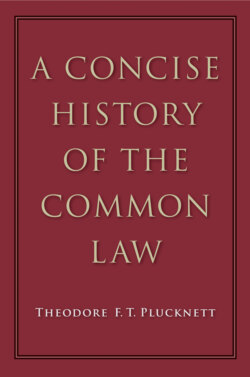Читать книгу A Concise History of the Common Law - Theodore F. T. Plucknett - Страница 19
На сайте Литреса книга снята с продажи.
CONSTITUTIONS OF CLARENDON
ОглавлениеThe reign opens (1154) with the confirmation of Henry I’s Charter of 1100, and with the great conflict between the King and Archbishop Becket. The separation of the ecclesiastical courts by William the Conqueror had had unexpected results, for in the succeeding hundred years the Church had developed a large mass of canon law and claimed wide jurisdiction. This law Becket determined to apply rigorously. Henry was equally determined to impose his own lay law (which also had recently been considerably enlarged in content and strengthened administratively).2 Many people were amenable in criminal matters to both jurisdictions, and Becket proclaimed that such people should not be tried twice—in other words, they should be tried but once, and that in the Church courts. Then certain things also were subject to both jurisdictions—Church lands, and the rights of ecclesiastical patronage (called advowsons). Finally, at a council in 1164 all the magnates of the realm “recognised” (the word is borrowed from the “recognition” or verdict of a jury) a list of customs which they declared were the practice of the reign of Henry I.
This statement, called the Constitutions of Clarendon, Henry II proposed as the basis of a compromise.3 Some of these provisions repeat practices dating from the reign of William I, such as in requiring the King’s permission before a tenant-in-chief can be excommunicated, or an appeal carried from the Church courts in England to Rome (cc. 7, 8, 10). Chapter 13 introduces the striking rule that a lord shall be held responsible by the King if his servants do wrong to a bishop. All litigation concerning advowsons is to be in the King’s court (c. 1), and so also cases involving the Church’s lands unless they be held in free alms (a tenure comporting no earthly services, and peculiar to Church property), but the fact of free alms or lay tenure is to be decided in the King’s court—which had been the rule in Normandy as well (c. 9). Chapter 15 contains the highly important rule that no plea of debt shall be withdrawn from the King’s jurisdiction on the grounds that the debt was accompanied by an oath or pledge of faith—spiritual censures may be imposed for breach of faith, but the civil jurisdiction over debt is not to be thereby ousted. This clause was not an unmixed benefit, for although the State thereby appropriated to itself a large jurisdiction over contract, nevertheless the law of the Church in this field was rapidly becoming more modern, more equitable and less formalistic. She had long punished breach of faith as a crime, and was soon to extend the idea and proclaim in addition the enforceability in law of promises (opinions to this effect appear first in 1212).1
Finally, it was declared by chapter 3 that clerks (that is to say, all who were in major or minor orders) when under accusation of crime should first answer in the King’s court, and then be remitted for trial by the bishop, and if he convicted, then they were to be returned to the lay court for punishment, for Henry insisted that degradation (the severest penalty the Church could inflict) was too mild for felonies. Last of all, Henry objected to laymen being tried in ecclesiastical courts, even for canonical offences, merely upon informations. So he offered the bishops the aid of a sheriff’s jury of presentment if the Church could find no other means of getting a public accuser.2
This compromise on the basis of old customs was effective, except as to the punishment of convicted clerks. On this point Henry had to yield after the murder of Becket in 1170, and thenceforward “benefit of clergy” eventually began to operate as a sort of first offender’s law, for it was the later rule that the culprit escaped punishment for the first offence only on proving his clergy.
